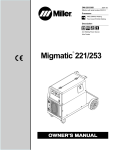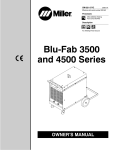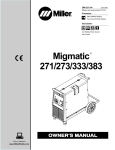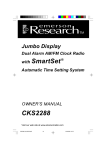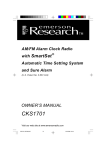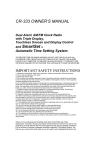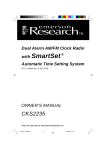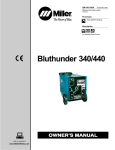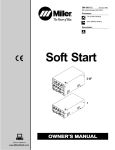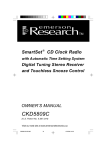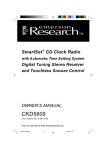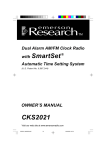Download Miller Electric MT-24VF-12-1 Owner`s manual
Transcript
OM-187 476D March 2003 Effective with serial number: 195 503 Processes MIG (GMAW) Welding Flux Cored (FCAW) Description Arc Welding Power Source Blu-Pak 35/45 Visit our website at www.MillerWelds.com OWNER’S MANUAL From Miller to You Thank you and congratulations on choosing Miller. Now you can get the job done and get it done right. We know you don’t have time to do it any other way. That’s why when Niels Miller first started building arc welders in 1929, he made sure his products offered long-lasting value and superior quality. Like you, his customers couldn’t afford anything less. Miller products had to be more than the best they could be. They had to be the best you could buy. Today, the people that build and sell Miller products continue the tradition. They’re just as committed to providing equipment and service that meets the high standards of quality and value established in 1929. This Owner’s Manual is designed to help you get the most out of your Miller products. Please take time to read the Safety precautions. They will help you protect yourself against potential hazards on the worksite. We’ve made installation and operation quick and easy. With Miller you can count on years of reliable service with proper maintenance. And if for some reason the unit needs repair, there’s a Troubleshooting section that will help you figure out what the problem is. The parts list will then help you to decide which exact part you may need to fix the problem. Warranty and service information for your particular model are also provided. Miller Electric manufactures a full line of welders and welding related equipment. For information on other quality Miller products, contact your local Miller distributor to receive the latest full line catalog or individual catalog sheets. Working as hard as you do – every power source from Miller is backed by the most hassle-free warranty in the business. TABLE OF CONTENTS SECTION 1 – SAFETY PRECAUTIONS–READ BEFORE USING . . . . . . . . . . 1-1. Symbol Usage . . . . . . . . . . . . . . . . . . . . . . . . . . . . . . . . . . . . . . . . . . . . . . . . . 1-2. Arc Welding Hazards . . . . . . . . . . . . . . . . . . . . . . . . . . . . . . . . . . . . . . . . . . . 1-3. Additional Symbols for Installation, Operation, and Maintenance . . . . . . 1-4. EMF Information . . . . . . . . . . . . . . . . . . . . . . . . . . . . . . . . . . . . . . . . . . . . . . . SECTION 2 – DEFINITIONS . . . . . . . . . . . . . . . . . . . . . . . . . . . . . . . . . . . . . . . . . . SECTION 3 – INTRODUCTION . . . . . . . . . . . . . . . . . . . . . . . . . . . . . . . . . . . . . . . . 3-1. Included with Your Unit . . . . . . . . . . . . . . . . . . . . . . . . . . . . . . . . . . . . . . . . . 3-2. Specifications . . . . . . . . . . . . . . . . . . . . . . . . . . . . . . . . . . . . . . . . . . . . . . . . . 3-3. Duty Cycle Chart . . . . . . . . . . . . . . . . . . . . . . . . . . . . . . . . . . . . . . . . . . . . . . . 3-4. Volt-Ampere Curves . . . . . . . . . . . . . . . . . . . . . . . . . . . . . . . . . . . . . . . . . . . . SECTION 4 – INSTALLATION . . . . . . . . . . . . . . . . . . . . . . . . . . . . . . . . . . . . . . . . . 4-1. Selecting a Location . . . . . . . . . . . . . . . . . . . . . . . . . . . . . . . . . . . . . . . . . . . . 4-2. Typical MIG Connections . . . . . . . . . . . . . . . . . . . . . . . . . . . . . . . . . . . . . . . 4-3. Electrical Service Guide . . . . . . . . . . . . . . . . . . . . . . . . . . . . . . . . . . . . . . . . 4-4. Connecting Input Power . . . . . . . . . . . . . . . . . . . . . . . . . . . . . . . . . . . . . . . . 4-5. Remote 14 Receptacle RC1 . . . . . . . . . . . . . . . . . . . . . . . . . . . . . . . . . . . . . SECTION 5 – OPERATION . . . . . . . . . . . . . . . . . . . . . . . . . . . . . . . . . . . . . . . . . . . 5-1. Controls . . . . . . . . . . . . . . . . . . . . . . . . . . . . . . . . . . . . . . . . . . . . . . . . . . . . . . SECTION 6 – MAINTENANCE AND TROUBLESHOOTING . . . . . . . . . . . . . . . 6-1. Routine Maintenance . . . . . . . . . . . . . . . . . . . . . . . . . . . . . . . . . . . . . . . . . . . 6-2. Troubleshooting . . . . . . . . . . . . . . . . . . . . . . . . . . . . . . . . . . . . . . . . . . . . . . . SECTION 7 - ELECTRICAL DIAGRAM . . . . . . . . . . . . . . . . . . . . . . . . . . . . . . . . . SECTION 8 - PARTS LIST . . . . . . . . . . . . . . . . . . . . . . . . . . . . . . . . . . . . . . . . . . . . WARRANTY 1 1 1 3 3 4 6 6 6 6 6 7 7 7 8 8 8 9 9 10 10 10 11 12 Declaration of Conformity Manufacturer’s Name: MILLER Europe S.r.l. Manufacturer’s Address: Via Privata Iseo, 6/E 20098 San Giuliano Milanese, Italy Declares that this product: Blu-Pak 35/45 Conforms to the following Directives and Standards: Directives Electromagnetic Compatibility Directives: 89/336/EEC Low Voltage: 73/23/EEC Machinery Directives: 89/392/EEC And their amendments 91/368/EEC, 93/31/EEC, 93/44/EEC, 93/68/EEC Standards Electromagnetic compatibility (EMC) Product standard for arc welding equipment: EN50199: August 1995 Safety Requirements for Arc Welding Equipment Part 1: EN 60974-1: 1989 European Contact: Telephone: Fax: dec_con1_italy_11/02 Ing. Danilo Fedolfi, Managing Director ITW WELDING PRODUCTS ITALY S.r.l. Via Privata Iseo, 6/E 20098 San Giuliano Milanese, Italy 39(0)298290-1 39(0)298290-203 SECTION 1 – SAFETY PRECAUTIONS–READ BEFORE USING som_woPSS_7/02 1-1. Symbol Usage Means Warning! Watch Out! There are possible hazards with this procedure! The possible hazards are shown in the adjoining symbols. Y Marks a special safety message. . Means “Note”; not safety related. This group of symbols means Warning! Watch Out! possible ELECTRIC SHOCK, MOVING PARTS, and HOT PARTS hazards. Consult symbols and related instructions below for necessary actions to avoid the hazards. 1-2. Arc Welding Hazards Y The symbols shown below are used throughout this manual to call attention to and identify possible hazards. When you see the symbol, watch out, and follow the related instructions to avoid the hazard. The safety information given below is only a summary of the more complete safety information found in the Safety Standards. Read and follow all Safety Standards. D Do not drape cables over your body. D If earth grounding of the workpiece is required, ground it directly with a separate cable. D Do not touch electrode if you are in contact with the work, ground, or another electrode from a different machine. Y Only qualified persons should install, operate, maintain, and repair this unit. D Use only well-maintained equipment. Repair or replace damaged parts at once. Maintain unit according to manual. D Wear a safety harness if working above floor level. Y During operation, keep everybody, especially children, away. ELECTRIC SHOCK can kill. Touching live electrical parts can cause fatal shocks or severe burns. The electrode and work circuit is electrically live whenever the output is on. The input power circuit and machine internal circuits are also live when power is on. In semiautomatic or automatic wire welding, the wire, wire reel, drive roll housing, and all metal parts touching the welding wire are electrically live. Incorrectly installed or improperly grounded equipment is a hazard. D Keep all panels and covers securely in place. D Clamp work cable with good metal-to-metal contact to workpiece or worktable as near the weld as practical. D Insulate work clamp when not connected to workpiece to prevent contact with any metal object. SIGNIFICANT DC VOLTAGE exists after removal of input power on inverters. D Turn Off inverter, disconnect input power, and discharge input capacitors according to instructions in Maintenance Section before touching any parts. D Do not touch live electrical parts. D Wear dry, hole-free insulating gloves and body protection. D Insulate yourself from work and ground using dry insulating mats or covers big enough to prevent any physical contact with the work or ground. D Do not use AC output in damp areas, if movement is confined, or if there is a danger of falling. D Use AC output ONLY if required for the welding process. D If AC output is required, use remote output control if present on unit. D Disconnect input power or stop engine before installing or servicing this equipment. Lockout/tagout input power according to OSHA 29 CFR 1910.147 (see Safety Standards). D Properly install and ground this equipment according to its Owner’s Manual and national, state, and local codes. D Always verify the supply ground – check and be sure that input power cord ground wire is properly connected to ground terminal in disconnect box or that cord plug is connected to a properly grounded receptacle outlet. D When making input connections, attach proper grounding conductor first – double-check connections. D Frequently inspect input power cord for damage or bare wiring – replace cord immediately if damaged – bare wiring can kill. D Turn off all equipment when not in use. D Do not use worn, damaged, undersized, or poorly spliced cables. FUMES AND GASES can be hazardous. Welding produces fumes and gases. Breathing these fumes and gases can be hazardous to your health. D Keep your head out of the fumes. Do not breathe the fumes. D If inside, ventilate the area and/or use exhaust at the arc to remove welding fumes and gases. D If ventilation is poor, use an approved air-supplied respirator. D Read the Material Safety Data Sheets (MSDSs) and the manufacturer’s instructions for metals, consumables, coatings, cleaners, and degreasers. D Work in a confined space only if it is well ventilated, or while wearing an air-supplied respirator. Always have a trained watchperson nearby. Welding fumes and gases can displace air and lower the oxygen level causing injury or death. Be sure the breathing air is safe. D Do not weld in locations near degreasing, cleaning, or spraying operations. The heat and rays of the arc can react with vapors to form highly toxic and irritating gases. D Do not weld on coated metals, such as galvanized, lead, or cadmium plated steel, unless the coating is removed from the weld area, the area is well ventilated, and if necessary, while wearing an air-supplied respirator. The coatings and any metals containing these elements can give off toxic fumes if welded. OM-187 476 Page 1 ARC RAYS can burn eyes and skin. Arc rays from the welding process produce intense visible and invisible (ultraviolet and infrared) rays that can burn eyes and skin. Sparks fly off from the weld. D Wear a welding helmet fitted with a proper shade of filter to protect your face and eyes when welding or watching (see ANSI Z49.1 and Z87.1 listed in Safety Standards). D Wear approved safety glasses with side shields under your helmet. D Use protective screens or barriers to protect others from flash and glare; warn others not to watch the arc. D Wear protective clothing made from durable, flame-resistant material (leather and wool) and foot protection. WELDING can cause fire or explosion. Welding on closed containers, such as tanks, drums, or pipes, can cause them to blow up. Sparks can fly off from the welding arc. The flying sparks, hot workpiece, and hot equipment can cause fires and burns. Accidental contact of electrode to metal objects can cause sparks, explosion, overheating, or fire. Check and be sure the area is safe before doing any welding. D Protect yourself and others from flying sparks and hot metal. D Do not weld where flying sparks can strike flammable material. D Remove all flammables within 35 ft (10.7 m) of the welding arc. If this is not possible, tightly cover them with approved covers. D Be alert that welding sparks and hot materials from welding can easily go through small cracks and openings to adjacent areas. D Watch for fire, and keep a fire extinguisher nearby. D Be aware that welding on a ceiling, floor, bulkhead, or partition can cause fire on the hidden side. D Do not weld on closed containers such as tanks, drums, or pipes, unless they are properly prepared according to AWS F4.1 (see Safety Standards). D Connect work cable to the work as close to the welding area as practical to prevent welding current from traveling long, possibly unknown paths and causing electric shock and fire hazards. D Do not use welder to thaw frozen pipes. D Remove stick electrode from holder or cut off welding wire at contact tip when not in use. D Wear oil-free protective garments such as leather gloves, heavy shirt, cuffless trousers, high shoes, and a cap. D Remove any combustibles, such as a butane lighter or matches, from your person before doing any welding. FLYING METAL can injure eyes. D Welding, chipping, wire brushing, and grinding cause sparks and flying metal. As welds cool, they can throw off slag. D Wear approved safety glasses with side shields even under your welding helmet. OM-187 476 Page 2 BUILDUP OF GAS can injure or kill. D Shut off shielding gas supply when not in use. D Always ventilate confined spaces or use approved air-supplied respirator. HOT PARTS can cause severe burns. D Do not touch hot parts bare handed. D Allow cooling period before working on gun or torch. MAGNETIC FIELDS can affect pacemakers. D Pacemaker wearers keep away. D Wearers should consult their doctor before going near arc welding, gouging, or spot welding operations. NOISE can damage hearing. Noise from some processes or equipment can damage hearing. D Wear approved ear protection if noise level is high. CYLINDERS can explode if damaged. Shielding gas cylinders contain gas under high pressure. If damaged, a cylinder can explode. Since gas cylinders are normally part of the welding process, be sure to treat them carefully. D Protect compressed gas cylinders from excessive heat, mechanical shocks, slag, open flames, sparks, and arcs. D Install cylinders in an upright position by securing to a stationary support or cylinder rack to prevent falling or tipping. D Keep cylinders away from any welding or other electrical circuits. D Never drape a welding torch over a gas cylinder. D Never allow a welding electrode to touch any cylinder. D Never weld on a pressurized cylinder – explosion will result. D Use only correct shielding gas cylinders, regulators, hoses, and fittings designed for the specific application; maintain them and associated parts in good condition. D Turn face away from valve outlet when opening cylinder valve. D Keep protective cap in place over valve except when cylinder is in use or connected for use. D Read and follow instructions on compressed gas cylinders, associated equipment, and CGA publication P-1 listed in Safety Standards. 1-3. Additional Symbols for Installation, Operation, and Maintenance FIRE OR EXPLOSION hazard. MOVING PARTS can cause injury. D Do not install or place unit on, over, or near combustible surfaces. D Do not install unit near flammables. D Do not overload building wiring – be sure power supply system is properly sized, rated, and protected to handle this unit. D Keep away from moving parts such as fans. D Keep all doors, panels, covers, and guards closed and securely in place. FALLING UNIT can cause injury. H.F. RADIATION can cause interference. D Use lifting eye to lift unit only, NOT running gear, gas cylinders, or any other accessories. D Use equipment of adequate capacity to lift and support unit. D If using lift forks to move unit, be sure forks are long enough to extend beyond opposite side of unit. D OVERUSE can cause OVERHEATING D D Allow cooling period; follow rated duty cycle. D Reduce current or reduce duty cycle before starting to weld again. D Do not block or filter airflow to unit. D D D High-frequency (H.F.) can interfere with radio navigation, safety services, computers, and communications equipment. D Have only qualified persons familiar with electronic equipment perform this installation. The user is responsible for having a qualified electrician promptly correct any interference problem resulting from the installation. If notified by the FCC about interference, stop using the equipment at once. Have the installation regularly checked and maintained. Keep high-frequency source doors and panels tightly shut, keep spark gaps at correct setting, and use grounding and shielding to minimize the possibility of interference. STATIC (ESD) can damage PC boards. D Put on grounded wrist strap BEFORE handling boards or parts. D Use proper static-proof bags and boxes to store, move, or ship PC boards. ARC WELDING can cause interference. MOVING PARTS can cause injury. D Keep away from moving parts. D Keep away from pinch points such as drive rolls. D D WELDING WIRE can cause injury. D Do not press gun trigger until instructed to do so. D Do not point gun toward any part of the body, other people, or any metal when threading welding wire. D D D Electromagnetic energy can interfere with sensitive electronic equipment such as computers and computer-driven equipment such as robots. D Be sure all equipment in the welding area is electromagnetically compatible. To reduce possible interference, keep weld cables as short as possible, close together, and down low, such as on the floor. Locate welding operation 100 meters from any sensitive electronic equipment. Be sure this welding machine is installed and grounded according to this manual. If interference still occurs, the user must take extra measures such as moving the welding machine, using shielded cables, using line filters, or shielding the work area. 1-4. EMF Information Considerations About Welding And The Effects Of Low Frequency Electric And Magnetic Fields Welding current, as it flows through welding cables, will cause electromagnetic fields. There has been and still is some concern about such fields. However, after examining more than 500 studies spanning 17 years of research, a special blue ribbon committee of the National Research Council concluded that: “The body of evidence, in the committee’s judgment, has not demonstrated that exposure to powerfrequency electric and magnetic fields is a human-health hazard.” However, studies are still going forth and evidence continues to be examined. Until the final conclusions of the research are reached, you may wish to minimize your exposure to electromagnetic fields when welding or cutting. To reduce magnetic fields in the workplace, use the following procedures: 1. Keep cables close together by twisting or taping them. 2. Arrange cables to one side and away from the operator. 3. Do not coil or drape cables around your body. 4. Keep welding power source and cables as far away from operator as practical. 5. Connect work clamp to workpiece as close to the weld as possible. About Pacemakers: Pacemaker wearers consult your doctor first. If cleared by your doctor, then following the above procedures is recommended. OM-187 476 Page 3 SECTION 2 – DEFINITIONS Warning! Watch Out! There are possible hazards as shown by the symbols. 1 Electric shock can kill. 1.1 Wear dry insulating gloves. Do not touch electrode with bare hand. Do not wear wet or damaged gloves. 1.2 Protect yourself from electric shock by insulating yourself from work and ground. 1.3 Disconnect input plug or power before working on machine. 2 Breathing welding fumes can be hazardous to your health. OM-187 476 Page 4 2.1 Keep your head out of the fumes. 2.2 Use forced ventilation or local exhaust to remove the fumes. 2.3 Use ventilating fan to remove fumes. 3 Welding sparks can cause explosion or fire. 3.1 Keep flammables away from welding. Do not weld near flammables. 3.2 Welding sparks can cause fires. Have a fire extinguisher nearby, and have a watchperson ready to use it. 3.3 Do not weld on drums or any closed containers. 4 Arc rays can burn eyes and injure skin. 4.1 Wear hat and safety glasses. Use ear protection and button shirt collar. Use welding helmet with correct shade of filter. Wear complete body protection. 5 Become trained and read the instructions before working on the machine or welding. 6 Do not remove or paint over (cover) the label. Warning! Watch Out! There are possible hazards as shown by the symbols. Electric shock from wiring can kill. Disconnect input plug or power before working on machine. Read the Owner’s Manual before working on this machine. 1 Consult rating label for input power requirements, and check power available at the job site – they must match. Read Owner’s Manual and inside labels for connection points and procedures. Move jumper links as shown on inside label to match voltage at job site. Having a loop of extra length, connect grounding conductor first. Connect line input conductors as shown on inside label – double-check all connections, jumper link positions, and input voltage before applying power. 2 3 4 5 1 1 Warning! Watch Out! There are possible hazards as shown by the symbols. Moving parts, such as fans, can cut fingers and hands and cause injury. Keep away from moving parts. 2 2 S-176 106 1 1 1 2 3 2 Warning! Watch Out! There are possible hazards as shown by the symbols. Falling unit can cause injury. Do not move or operate unit where it could tip. Cylinders can expolde if damaged. Protect compressed gas cylinders from excessive heat, mechanical shock, slag, open flames, sparks, and arcs. 3 OM-187 476 Page 5 SECTION 3 – INTRODUCTION 3-1. Included with Your Unit 1 1 2 3 4 Power Source Power Cord (4m) Work Cable and Clamp (4m) Running Gear 2 3 4 3-2. Specifications Rated Output at 45% Duty Cycle Welding Range Max. OVC Input Rating KVA Dimensions Net Weight Blu-Pak 35 350 A 32 V 16-32 38 230-31A 400–18A 11.8 KVA Length: 1040mm Height: 760mm Width: 435mm 146 kg Blu-Pak 45 450 A 37 V 14-37 47 230-46A 400-27A 17.7 KVA Length: 1040mm Height: 760mm Width: 435mm 156 kg 3-3. Duty Cycle Chart Duty cycle is percentage of 10 minutes that unit can weld at rated load without overheating. Y Exceeding duty cycle can damage unit and void warranty. WELDING AMPERES 800 700 Blu-Pak 35: 45% Duty Cycle at 32V, 350A 600 500 Blu-Pak 45: 45% Duty Cycle at 37V, 450A 400 450 300 200 20 350 4.5 Minutes Welding 25 30 35 40 50 60 708090100 % DUTY CYCLE 3-4. Volt-Ampere Curves Blu-Pak 35 OM-187 476 Page 6 Blu-Pak 45 5.5 Minutes Resting SECTION 4 – INSTALLATION 4-1. Selecting a Location Position unit so air can circulate. 500 mm 500 mm 500 mm 4-2. Typical MIG Connections 6 1 Power source 2 Work clamp (connect to receptacle as shown) 3 Water cooler for torch 4 Cylinder (chain to running gear) 5 Cylinder valve 5 7 Open valve slightly so gas flow blows dirt from valve. Close valve. 6 Regulator/Flow gauge Install so face is vertical 7 Flow adjust 8 Gas supply line 9 Wire feeder 8 4 3 10 MIG torch 9 1 10 2 OM-187 476 Page 7 4-3. Electrical Service Guide Blu-Pak 35 Input Voltage Blu-Pak 45 230 400 230 400 Input amperes at rated output 36A 21A 52A 30A Fuse or circuit breaker rating (max. rec) 36A 21A 52A 30A Input conductor size* 6 mm2 6 mm2 6 mm2 6 mm2 Grounding conductor size** 6 mm2 6 mm2 6 mm2 6 mm2 * Power cord supplied with the unit is sized for 230V operation. ** Larger power cord may be required for cable length greater than 3 meters. Consult national or local regulations. 4-4. Connecting Input Power ST-161 454-A GND/PE Y Have only qualified persons make this installation. Y Special installation may be required where gasoline or volatile liquids are present – consult national or local regulations. GND/PE Connect first. L1 L2 L3 Tools Needed: 4-5. Remote 14 Receptacle RC1 Socket OUTPUT (CONTACTOR) 24 VOLTS AC 115 VOLTS AC GND OM-187 476 Page 8 OUTPUT Information A 24 volts ac. B Contact closure to A completes 24 volts ac contactor control circuit. I 115 volts AC, protected by fuse. K Chassis common. G Circuit common for 24 and 115 volts ac circuits. SECTION 5 – OPERATION 5-1. Controls Ref. ST-155 790-F 1 Power Switch 2 5 6 The power switch is a selector knob which permits selection of operation on either of the two available ranges (I and II) and the center position is off. 2 Indicator Lamp This lights up when the power switch is placed in the ON position. 3 1 Protection Fuse Fuse F protects the control circuit. Should it become necesary to replace any fuse in the welding power source, be sure to substitute with one of the same size and rating. 4 High Temperature Shutdown Light 3 4 7 This lights up when unit overheats and shuts down. 5 Use this control to adjust weld voltage 10 position switch. 20 weld setting, 10 high range (I), 10 low range (II). 6 Voltage/Amperage Meter. 8 Use toggle switch to select voltage or amperage. 7 Low Inductance Negative Output Terminal Connect work lead here for most “short-arc” applications. 8 Front Panel High Inductance Negative Terminal Connect work lead here for stainless steel and spray arc conditions. 9 9 10 11 115 a.c. Receptacle Located on the rear panel is a receptacle which provides power to the gas heater, when welding with CO2 shielding gas and for the cooling system. 10 Wire Feeder Power Cable Receptacle Located on the rear panel is a receptacle used to supply operating power to the wire feed unit. 11 Positive Out Terminal 115 VAC Back Panel OM-187 476 Page 9 SECTION 6 – MAINTENANCE AND TROUBLESHOOTING 6-1. Routine Maintenance Y Disconnect power before maintaining. . Maintain more often during severe conditions. 3 Months Replace unreadable labels. Clean and tighten weld terminals. Repair or replace cracked weld cable. Repair or replace cracked gas hose. Replace o-ring in Electrode/Gas Output receptacle if cracked. 6 Months Blow out or vacuum inside. OR 6-2. Troubleshooting Trouble Remedy No weld output; fan does not run. Place line disconnect switch in On position (see Section 4-4). Check and replace line fuse(s), if necessary, or reset circuit breaker (see Section 4-4). Check for proper input power connections (see Section 4-4). No weld output; fan on. Check and replace if necessary (see Section 5-1) Tighten wire feeder connection to Remote 14 receptacle. Unit overheated. Allow unit to cool (see Section 3-3). Fan not operating; weld output available. Check for and remove anything blocking fan movement. Have Factory Authorized Service Agent check fan motor. OM-187 476 Page 10 3 F 1 22 B CR 20 AT GND 5 IN RECT.TP R S T 13 OL FM W W 2 G w 6 RC1 23 R 21 A RC2 230V S3 14 W PL 20 10 11 W C1 S2 RL 1 1 2 3 4 5 6 7 8 910 1112 SL 2 C2 4 TL 3 K 24V RC3 9 C3 T3 L 115 115V 400V Y Z X PRI. POSIZIONI 7 U 8 S3 2 1 2 1 2 1 B MT B V 19 W B RL 1 S2 SL 2 R1 TL 3 1 2 3 4 5 6 7 8 9 10 1112 B B B SEC. SR1 RC1 Vc 28 26 25 SHUNT DIGITAL A-V X X 1X 2 X X X X 3 X X X 4 X X 5 X X X X 6 X X X 7 X X 8 X X X 9 X X X X 10 X X Z W + 27 24 1 2 3 4 5 6 29 31 30 12 24 Vac SECTION 7 - ELECTRICAL DIAGRAM 7-1. Blu-Pak 35/45 cod.956.142.300/956.142.301 OM-187 476 Page 11 SECTION 8 - PARTS LIST 8-1. Main Assembly 1 45 2 10 35 34 36 40 3 37 33 39 38 32 4 5 31 30 6 29 7 41 43 8 28 9 27 26 25 10 23 42 51 20 52 19 44 24 12 15 11 50 13 49 14 48 16 47 46 OM-187 476 Page 12 17 18 21 22 Dia Item Ref. Code 1 116121119 2 156002023 3 PL 056072054 4 058020044 4 056020042 5 000046432 6 F 056092039 7 OL 056072062 8 056020043 8 056020031 9 116118150 10 50mmq 056076152 10 70mmq 056076169 11 056054065 12 116085123 13 116005081 14 TP.NC.110_ 056159008 15 SR1 056050058 15 SR1 056050017 16 SHUNT 056059257 16 SHUNT 056059262 17 MT 230/400V 028021447 17 MT 230/400V 028021448 18 PRI. SEC 027015542 230/400V 18 PRI. SEC 027015541 230/400V 19 156031040 20 Z 028038040 20 Z 028038041 21 556070011 22 756069012 23 156006030 24 W 057079033 Aux. Contact 056070038 24 W 057079034 Aux. Contact 056070038 Qty. Dwg 35 45 XH.0.0.3 1 1 VS.0.0.15 2 2 EG.1.0.4 1 1 VS.0.0.17 1 VT.0.0.5 1 OL.0.0.14 EZ.4.0.5 1 1 QF.0.0.10 1 1 VS.0.0.16 1 MN.3.0.3 1 VS.0.0.2 1 1 DD.0.0.7 3 DI.11.0.2 3 VS.0.014 2 2 VS.0.0.8 1 1 XH.0.0.11 1 1 QF.0.0.7 1 1 HC.0.0.2 1 AS.0.0.1 1 UV.3.0.1 1 VT.0.0.1 1 VS.8 1 VT.6 1 VS.1.1 3 VT.1.1 VT.0.0.7 VS.2 VT.2 HD.0.02 BO.0.0.6 XH.0.0.6 VS.0.31 VT.0.13 3 1 1 4 1 1 1 1 1 4 1 1 1 Dia Item Ref. Code 25 056054064 26 156009067 27 156087017 28 057029005 29 117029078 30 057014030 31 356078032 32 116118151 33 000173283 34 RC2 000604176 35 RC1 056076170 36 Destra/Right 116122277 36 Sinstra/Left 116122278 37 000124274 38 FM 000116190 (230V, 50/60 Hz) 39 S2 056067196 39 S2 056067205 40 S3 056067203 40 S3 056067204 41 A-V 027095012 41 A-V 027095013 42 AT 058021042 43 656089005 R 056059189 C1-C2-C3 057024004 44 116122280 45 CR 000006393 46 47 156085088 48 156085087 49 156031032 50 156031034 51 157029012 52 156031033 Qty. 35 45 2 2 6 6 2 2 VS.0.3 1 1 VS.0.2 1 1 ML.0.3 1 1 PZ.0.0.8 1 1 VS.0.0.3 1 1 QB.0.0.13 1 1 EF.6.0.3 1 1 FS.1.0.3 1 1 VS.0.0.5 1 1 VS.0.0.6 1 1 QA.0.4.3 1 1 QB.0.12 1 1 Dwg VS.0.013 UV.0.011 VT.0.0.3 VS.0.0.10 VT.0.0.2 VS.5.1 VT.4.1 MI.5 EZ.5.0.1 DH.6.0.4 PG.0.7 VS.0.0.11 QA.0.0.10 XH.0.0.10 XH.0.0.8 XH.0.0.7 XH.0.0.12 XH.0.0.14 XH.0.3 XH.0.0.13 1 1 1 1 1 1 1 1 1 1 1 4 2 2 1 1 1 1 1 1 1 1 1 1 1 4 2 2 1 1 1 1 OM-187 476 Page 13 Notes Effective January 1, 2002 This limited warranty supersedes all previous Miller warranties and is exclusive with no other guarantees or warranties expressed or implied. * LIMITED WARRANTY – Subject to the terms and conditions below, Miller Europe S.r.l., Milan Italy, warrants to its original retail purchaser that new Miller equipment sold after the effective date of this limited warranty is free of defects in material and workmanship at the time it is shipped by Miller. THIS WARRANTY IS EXPRESSLY IN LIEU OF ALL OTHER WARRANTIES, EXPRESS OR IMPLIED, INCLUDING THE WARRANTIES OF MERCHANTABILITY AND FITNESS. Within the warranty periods listed below, Miller will repair or replace any warranted parts or components that fail due to such defects in material or workmanship. Miller must be notified in writing within thirty (30) days of such defect or failure, at which time Miller will provide instructions on the warranty claim procedures to be followed. Miller shall honor warranty claims on warranted equipment listed below in the event of such a failure within the warranty time periods. All warranty time periods start on the date that the equipment was delivered to the original retail purchaser, or one year after the equipment is sent to a European distributor or eighteen months after the equipment is sent to an International distributor. 1. 5 Years Parts – 3 Years Labor * * 2. 3 Years — Parts and Labor * * * * * * 3. 4. Original main power rectifiers Inverters (input and output rectifiers only) Transformer/Rectifier Power Sources Plasma Arc Cutting Power Sources Semi-Automatic and Automatic Wire Feeders Inverter Power Supplies Intellitig Engine Driven Welding Generators except Panther (NOTE: Engines are warranted separately by the engine manufacturer.) 2 year – Parts and Labor (Panther only) (NOTE: Engines are warranted separately by the engine manufacturer.) 1 year – Parts and Labor unless specified * DS-2 Feeder * Motor Driven Guns (w/exception of Spoolguns) * Process Controllers * Positioners and Controllers * Automatic Motion Devices * RFCS Foot Controls * IHPS Power Sources * Water Coolant Systems * Flowgaruge and Flowmeter Regulators (No Labor) * HF Units * Grids * Maxstar 140 * Spot Welders * Load Banks * Miller Cyclomatic Equipment * Running Gear/Trailers * Plasma Cutting Torches (except APT & SAF Models) * Field Options (NOTE: Field options are covered under True Blue for the remaining warranty period of the product they are installed in, or for a minimum of one year — whichever is greater.) 5 6 Months — Batteries 6. 90 Days — Parts * * MIG Guns/TIG Torches Induction heating coils and blankets * * * * * APT, ZIPCUT & PLAZCUT Model Plasma Cutting Torches Remote Controls Accessory Kits Replacement Parts (No labor) Spoolmate Spoolguns Canvas covers Miller’s True Blue Limited Warranty shall not apply to: 1. Consumable components; such as contact tips, cutting nozzles, contactors, brushes, slip rings, relays or parts that fail due to normal wear. 2. Items furnished by Miller, but manufactured by others, such as engines or trade accessories. These items are covered by the manufacturer’s warranty, if any. 3. Equipment that has been modified by any party other than Miller, or equipment that has been improperly installed, improperly operated or misused based upon industry standards, or equipment which has not had reasonable and necessary maintenance, or equipment which has been used for operation outside of the specifications for the equipment. MILLER PRODUCTS ARE INTENDED FOR PURCHASE AND USE BY COMMERCIAL/INDUSTRIAL USERS AND PERSONS TRAINED AND EXPERIENCED IN THE USE AND MAINTENANCE OF WELDING EQUIPMENT. In the event of a warranty claim covered by this warranty, the exclusive remedies shall be, at Miller’s option: (1) repair; or (2) replacement; or, where authorized in writing by Miller in appropriate cases, (3) the reasonable cost of repair or replacement at an authorized Miller service station; or (4) payment of or credit for the purchase price (less reasonable depreciation based upon actual use) upon return of the goods at customer’s risk and expense. Miller’s option of repair or replacement will be F.O.B., Factory at Appleton, Wisconsin, or F.O.B. at a Miller authorized service facility as determined by Miller. Therefore no compensation or reimbursement for transportation costs of any kind will be allowed. TO THE EXTENT PERMITTED BY LAW, THE REMEDIES PROVIDED HEREIN ARE THE SOLE AND EXCLUSIVE REMEDIES. IN NO EVENT SHALL MILLER BE LIABLE FOR DIRECT, INDIRECT, SPECIAL, INCIDENTAL OR CONSEQUENTIAL DAMAGES (INCLUDING LOSS OF PROFIT), WHETHER BASED ON CONTRACT, TORT OR ANY OTHER LEGAL THEORY. ANY EXPRESS WARRANTY NOT PROVIDED HEREIN AND ANY IMPLIED WARRANTY, GUARANTY OR REPRESENTATION AS TO PERFORMANCE, AND ANY REMEDY FOR BREACH OF CONTRACT TORT OR ANY OTHER LEGAL THEORY WHICH, BUT FOR THIS PROVISION, MIGHT ARISE BY IMPLICATION, OPERATION OF LAW, CUSTOM OF TRADE OR COURSE OF DEALING, INCLUDING ANY IMPLIED WARRANTY OF MERCHANTABILITY OR FITNESS FOR PARTICULAR PURPOSE, WITH RESPECT TO ANY AND ALL EQUIPMENT FURNISHED BY MILLER IS EXCLUDED AND DISCLAIMED BY MILLER. Some states in the U.S.A. do not allow limitations of how long an implied warranty lasts, or the exclusion of incidental, indirect, special or consequential damages, so the above limitation or exclusion may not apply to you. This warranty provides specific legal rights, and other rights may be available, but may vary from state to state. In Canada, legislation in some provinces provides for certain additional warranties or remedies other than as stated herein, and to the extent that they may not be waived, the limitations and exclusions set out above may not apply. This Limited Warranty provides specific legal rights, and other rights may be available, but may vary from province to province. milan_warr 10/02 Owner’s Record Please complete and retain with your personal records. Model Name Serial/Style Number Purchase Date (Date which equipment was delivered to original customer.) Distributor Address Country Zip/Postal Code Miller Europe Italy Phone: 39 (0) 2982901 European Headquarters – United Kingdom Phone: 44 (0) 1204-593493 FAX: 44 (0) 1204-598066 Miller Electric Mfg. Co. An Illinois Tool Works Company 1635 West Spencer Street Appleton, WI 54914 USA International Headquarters–USA Phone: 920-735-4505 USA & Canada FAX: 920-735-4134 International FAX: 920-735-4125 PRINTED IN USA 2003 Miller Electric Mfg. Co. 1/03





















